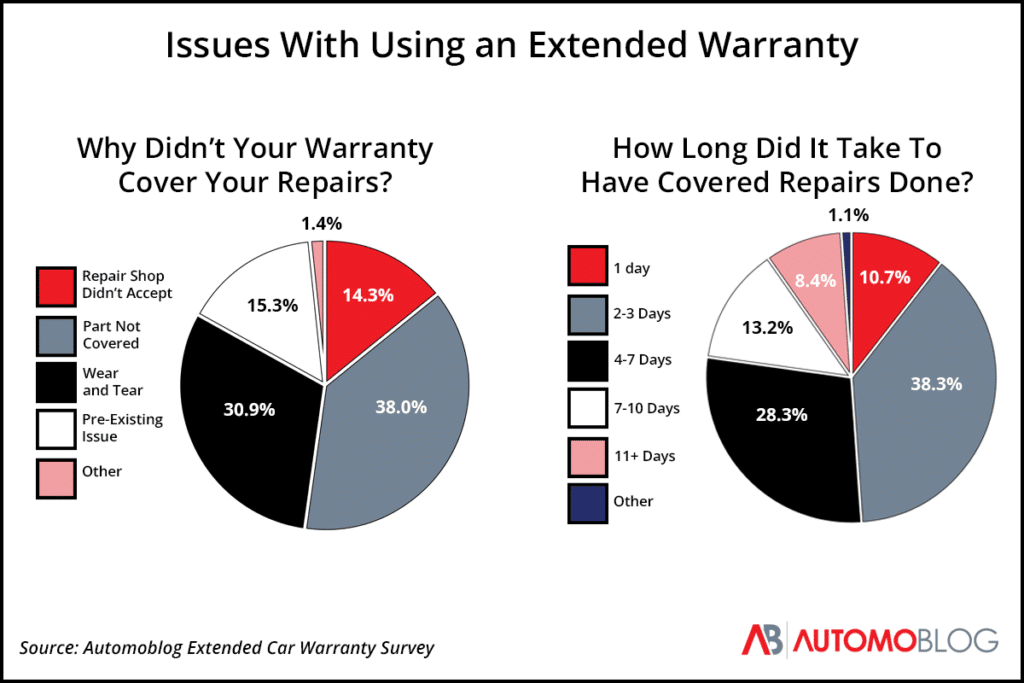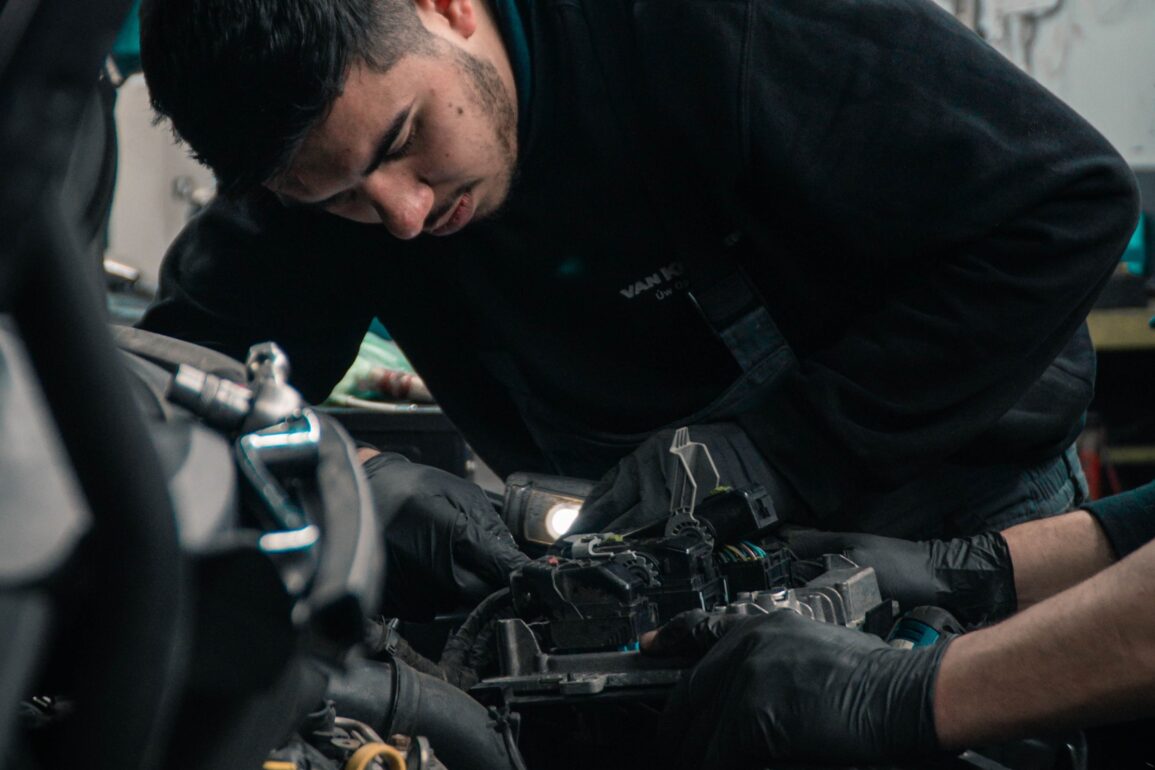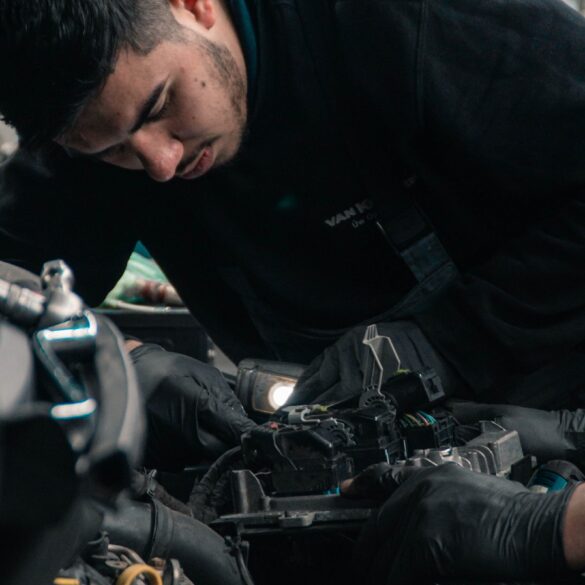Affiliate Disclosure: Automoblog and its partners may earn a commission if you purchase coverage from the extended warranty providers outlined here. These commissions come to us at no additional cost to you. Our research team has carefully vetted dozens of extended warranty providers. See our Privacy Policy to learn more.
Extended car warranties – whether from a manufacturer, dealership, or independent provider – can prevent you from forking over large sums of money to cover an unexpected repair. But even when drivers have extended coverage on their vehicles, using that coverage can be a challenge, which often comes as a surprise to the policyholder.
Issues With Using Extended Warranty Coverage
In a recent poll, we surveyed 1,000 people who had purchased an extended car warranty. We asked several questions about how difficult it was to use their coverage and what issues they encountered, if any.

One of the main issues expressed by warranty customers was their warranty plans not covering their repairs as expected. Around 24.8% of warranty customers in total said their warranty covered either none or only some of their repairs. The most common reason was a specific part not being covered, accounting for 38% of claim denials. At 30.9%, wear and tear was the second-most common reason warranty claims were denied, followed by pre-existing issues at 15.3%, and repair shops not accepting warranty work at 14.3%.
Another issue was the amount of time it took to have warranty work completed. In our survey, 89.3% of respondents said that their covered repairs took at least two to three days to complete. Around 21.6% said that repairs took seven days or more to finish. Only 10.7% of those surveyed had their work finished within one day.
Warranty Tips From a Repair Shop Owner
Extended auto warranties don’t come cheap. According to our survey, the median price for non-manufacturer extended coverage was around $2,323 in total. Warranty holders understandably hope to get what they pay for.

Strut Daddy’s Complete Car Care
We spoke with Matt Lofton, owner and president of Strut Daddy’s Complete Car Care in Roxboro, North Carolina to learn his perspective on getting the most out of a warranty plan. Strut Daddy’s is one of many ASE-Certified shops that accepts warranty work, and Lofton has years of experience dealing with providers and policyholders.
He said that there can be some challenges for all parties involved in the warranty repairs process. But he also emphasized that there are some things policyholders can do to make sure things go as smoothly as possible. Lofton gave us six tips for using an extended warranty for covered repairs to pass on to Automoblog readers.
1. Review Your Contract, Especially the “Exclusions” Page
“As a policyholder of an extended car care warranty, your first step when encountering an issue you believe is covered is to carefully examine your contract. Pay close attention to the “Exclusions” page, which outlines the items or systems not covered by your current plan.”
2. Understand Your Waiting Period
“Most policies have a waiting period, also known as a maturation date, which means you cannot submit a claim until that date has been satisfied. For instance, if your policy has a 90-day maturation date and you attempt to file a claim within those 90 days, your claim will be denied. The issue will also be considered a pre-existing condition, voiding coverage for future claims as well.”
3. Keep Maintenance Records for Engine and Transmission Issues
“If your problem is related to the engine or transmission, it’s crucial to have your maintenance records organized. Claims adjusters often request to see the last three fluid services to ensure that you have been maintaining the vehicle according to the manufacturer’s recommended intervals.
Choosing a professional shop that saves your service records can greatly benefit you, as failure to provide these records may result in a claim denial.”
4. Schedule Regular Preventative Maintenance
“To maintain your warranty claim status and keep your vehicle operating as intended, it’s vital to schedule regular preventative maintenance with your repair provider. This not only preserves your warranty coverage but also helps your vehicle perform optimally.”
5. Arrange Alternative Transportation in Advance
“Before scheduling repairs with the repair facility, make sure you have an alternative mode of transportation secured. It’s important to note that your warranty company is not responsible for providing a rental vehicle until your claim has been submitted and approved. Since the approval process can take time – sometimes up to two weeks for larger claims – having a plan for alternative transportation during this period is essential.
6. Be Patient
“Be patient throughout the warranty process and understand the roles of different parties involved. When you contact the warranty company as a customer, you’ll typically speak to a customer service representative whose main goal is to keep you satisfied. They may have limited knowledge about the claim’s status since they don’t have access to the same system as the claims adjuster.
As a repair facility, we work directly with the claims adjuster who ultimately approves or denies the claim. Calling the customer service representative every day may not significantly impact the speed of completion or the likelihood of claim approval, so patience is key in these situations.”
Warranties Can Be Helpful if Understood and Used Properly
An extended warranty plan can be a valuable tool for car owners, especially those who don’t always have access to the cash needed to pay for mechanical repairs. In our survey, 36.3% of respondents said they could only pay a maximum of $500 in an emergency for car repairs. Around 42.4% of those surveyed said they had no emergency fund at all.
Policyholders may not always get the full value of the coverage they pay for. Around 18.5% of people in our survey said they didn’t use their warranty to cover any repairs. But for the remaining 81.5% who did, their extended warranty kept them from having to pay for all or any of their repair costs. That monthly payment or lump sum is a tradeoff worth making for many, as it can act as an insurance policy against having to pay out of pocket for mechanical repairs.
However, if owners don’t fully understand the terms and conditions of their coverage – especially its exclusions – they could be spending money on a policy that doesn’t serve its expected purpose. By reading through a warranty contract fully before signing and following Lofton’s tips, policyholders have the best chance of getting the most out of their service plan.



